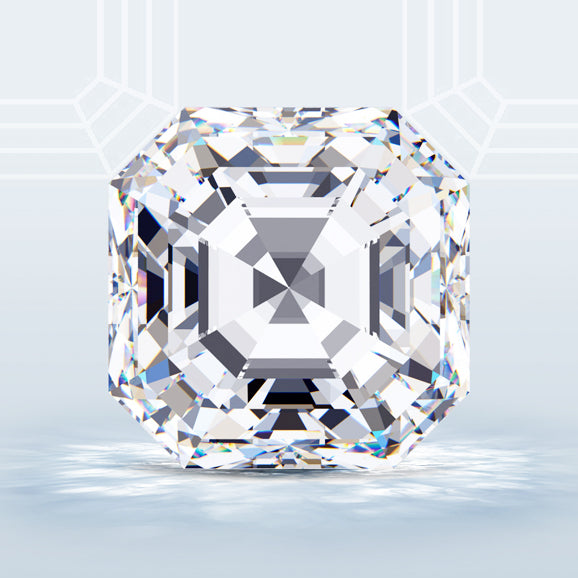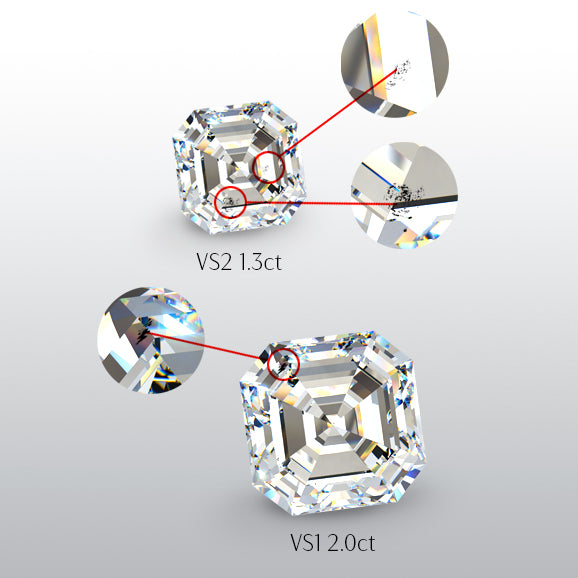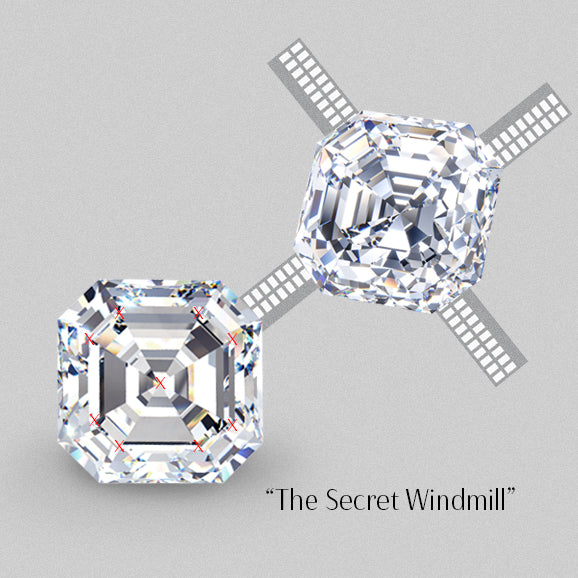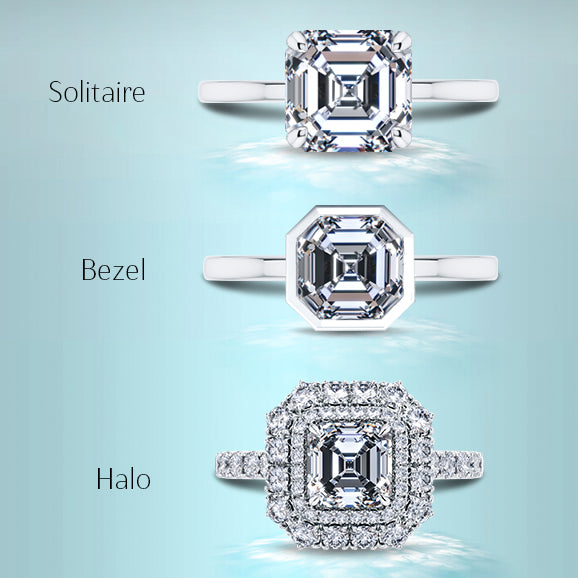
Asscher Cut Diamonds Explained
Ascher cut diamonds are square with clipped corners and stepped facets; many people think of them as being square emerald-cut diamonds. The corners give the overall square shape an octagonal appearance.
While they are similar to emerald cut gems, with 58 facets; asscher cut diamonds feature a smaller table (the flat top facet) and overall depth. These proportions give asscher cut diamonds more sparkle and brilliance than emerald cut gems.
Asscher cut diamonds remain less brilliant than some other shapes because they have an attractive step cut to the facets rather than many angled facets that trap and reflect light.
Buyers of asscher cut diamonds enjoy the elegant shape and cut that is reminiscent of the Art Deco period. You will not be following the crowd when you wear asscher cut diamonds as jewellery!

The Origin Of The Ascher Cut Diamond Shape
The asscher cut was developed by Joseph Asscher in 1902 and was the first diamond cut to be patented. The patent lasted until WW2, and now most asscher cut diamonds are not cut by the Royal Asscher company. More recently the company introduced the Royal Asscher cut, this is, once again patented. The cut has 74 facets for increased brilliance and sparkle.
All genuine Royal Asscher cut diamonds are laser inscribed with the Royal Asscher logo and an identification number. Both the GIA and AGS provide Royal Asscher cut diamonds with certification identifying the gems as having been cut by the company. There are now several Royal Asscher cut shapes including a round brilliant, cushion cut and oval cut. These should not be confused with the original square asscher cut described in this article.

How To Choose An Asscher Square Cut Diamond?
Asscher cut diamonds are typically cut with 58 facets but can be found with 49 or 65 facets.
Several different facet patterns can be used with varying numbers of steps to the pavilion and crown. (The pavilion is the lower portion of the diamond, usually below the setting and the crown is the upper part of the diamond, above the setting). In a diamond grading report, the number of steps will be shown in diagrammatic form. The number of steps will depend upon the shape of the rough crystal being cut. There is no single 'best' option when it comes to the number of steps. If you like the look of the diamond, then it has the right number of steps for you!

The Shape Of The Diamond
The asscher cut is a square, rather than a rectangle, so make sure that the diamond you buy is visually square. A slight rectangle will often look slightly 'off' and disproportionate. Ideally, you should choose a gem with a length to width ratio of 1.00-1.05. A ratio of less than 1.10 will look visually square.
In most respects, the final choice of an asscher cut diamond is a matter of taste. Experts suggest that a reasonably large table (the flat top facet) looks best with a percentage of the overall size of around 60-67%. The depth influences the perceived size of the diamond, with a deep stone leading to a smaller appearance when comparing diamonds of the same size but differing depths. A depth of around 60-65% of the width is a good target, although, in general, the more shallow, the better.
Both depth and table size will e recorded in the grading report.

Asscher Diamond Clarity
Asscher cut diamonds, in common with other shapes with a large table tend to show up inclusions and flaws more than brilliant-cut stones. Take care when choosing the grade of the diamond. Even with a high clarity grade, check that the stone you are considering does not have visible issues when looking down at the table. Experts suggest that the minimum clarity grade for a small (less than 1.5 carats) diamond should be VS2 or better. Larger diamonds need a higher clarity grade, and VS1 should be the minimum.

Asscher Diamond Colour
The step cut used in asscher cut diamonds tends to enhance any colouration present in the gem. If you want a white looking diamond, then choose a minimum of a G colour grade. If a warmer appearance is desired, then a lower colour grade is possible and can be enhanced by choosing a yellow metal setting.

Look For The Secret Windmill!
A well-cut asscher diamond will exhibit a characteristic windmill effect running from the corners of the stone to the centre. Many asscher shape diamonds are not cut well enough to show this effect.
Optimally, the windmill pattern will run to the centre of the stone, giving a delightful effect. At their best, asscher cut diamonds have a kind of kaleidoscope effect, if possible, choose a stone that offers that view.

The Best Settings For An Asscher Cut Diamond
Because asscher cut diamonds have clipped corners they are relatively robust. For a solitaire setting a setting with a prong at each corner will give a secure fitting that is fine for everyday wear.
If there is one setting style to avoid when choosing a ring with an asscher cut diamond, it is the bezel setting. The metal all around the diamond is not required as protection and only serves to make the diamond look less bright. The bezel gives a boxed in appearance that makes the gem look less brilliant and smaller.
A halo setting with a surround of smaller diamonds can make for an imposing ring with a perceived size enhancement at relatively low cost. The effect is very elegant and will please those who prefer art deco and vintage jewellery styles.
Although less brilliant than the modern round-cut shape, asscher cut diamonds have a charm and elegance that is all their own. Not as flashy, but with an understated touch of class asscher diamonds make an excellent choice for dress or engagement rings.